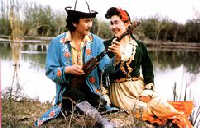|
The most celebrated music inXinjiangtoday is Uygur folk music, which has inherited the fine traditions of the ancient music of Qiuci, Gaochang (Karahoja),Yizhou, Shule and Yutian.

Due to the particular geography of Xinjiang and the constant influence of one culture on another, musical styles have developed along different paths over the years, and each tradition is typical of its locality. There are three distinct styles of Xinjiang music: Southern Xinjiang, Eastern Xinjiang and the Daolang area.
Southern Xinjiang is vast, and the content and form of its music varies from place to place. For example, Hotan folk songs are simple, short and primitive, reflecting the flavor of the land.Kashgarfolk songs, however, have a sophisticated rhythm, while Kuqa folk songs are lively, boisterous and perfect for dancing.
In Eastern Xinjiang, folk songs have the same structure as those of Han's and Mongolian folk songs.
Dolan area folk songs, from the western edge of the Tarim Basin, have an unrestrained style, retaining the mood of its ancient herdsmen.
In the Ili area, a large number of Uygur immigrants have helped to develop yet another style of Uygur music represented by drawn-out soulful tunes. A number of their songs are narrated and chantable.
There are several kinds of traditional Uygur music, the most famous of which is the classic Uygur musical composition the "Twelve Muqam", a major force in the development of Uygur folk music. This artistic gem combines folk music and dancing, and includes more than 340 classical songs, folk songs and pieces of dance and instrumental music. It has enticed people in both Northern and Southern Xinjiang for generations. Changing from overtures to allegrettos, followed by allegros, "The Twelve Muqam" lasts more than 20 hours. The piece was systematically recorded and published a few years ago.
|



